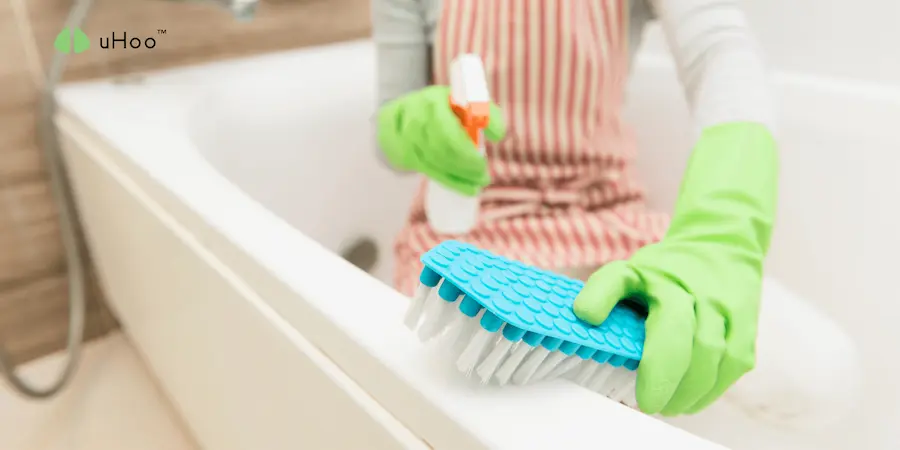Achieving a truly hygienic bathroom requires a strategic cleaning approach that tackles both wet and dry contaminants. Here are 10 detailed cleaning strategies to conquer moisture and dust, leaving your bathroom sparkling and healthy.
Strategy #1: Master the Art of Ventilation
Before any cleaning begins, prioritize ventilation. Run your exhaust fan during and for at least 15-20 minutes after showering or bathing. If you don’t have an exhaust fan, open a window to allow moisture to escape. Reducing humidity is the first crucial step in preventing dust from becoming sticky and encouraging mold growth, making cleaning significantly easier in the long run.
Strategy #2: The Pre-Clean Sweep (or Vacuum!)
Even in a moisture-prone environment, dry dust and hair accumulate. Before applying any wet cleaning methods, perform a dry pre-clean. Use a handheld vacuum with a brush attachment or a microfiber duster to tackle dust bunnies in corners, along baseboards, on shelves, and even on light fixtures. This prevents you from turning dry dust into a muddy mess when you introduce water.
Strategy #3: Top-Down Attack on Dust and Grime
Gravity is your cleaning companion. Start cleaning from the highest surfaces and work your way down. Begin with light fixtures, then move to shelves, mirrors, and finally the sink and toilet. This prevents dislodged dust and grime from landing on already cleaned areas.
Strategy #4: Conquer Shower and Tub Residue
The shower and tub are prime real estate for the marriage of moisture and dust, resulting in soap scum and mildew.
- Daily Squeegee: After each shower, use a squeegee on glass doors and tiled walls to remove excess water. This simple habit drastically reduces water spots and mildew buildup.
- Weekly Deep Clean: Use a bathroom-specific cleaner designed to tackle soap scum and mildew. For a natural approach, a paste of baking soda and water or a solution of white vinegar and dish soap can be effective. Allow the cleaner to sit for a few minutes before scrubbing with a non-scratch sponge or brush. Rinse thoroughly with hot water. Pay attention to grout lines, a notorious hiding spot for mildew.
Strategy #5: Shine Bright: Cleaning Mirrors and Glass
Dust and water spots can cloud your mirrors and glass surfaces. Use a microfiber cloth and a glass cleaner (or a solution of equal parts white vinegar and water) for streak-free shine. Spray the cleaner onto the cloth, not directly onto the surface, to prevent overspray.
Strategy #6: Tackle Toilet Dust and Germs
The toilet attracts both dry dust and airborne bacteria.
- Exterior Cleaning: Regularly wipe down the toilet handle, tank, lid, and base with a disinfectant cleaner or wipes. Pay attention to the crevices where dust can accumulate.
- Interior Cleaning: Use a toilet bowl cleaner and a toilet brush to scrub the inside of the bowl. Flush to rinse.
Strategy #7: Sink and Counter Command
Sinks and countertops are constantly exposed to water and various bathroom products, which can trap dust and create sticky residues. Wipe down these surfaces daily with a damp microfiber cloth. For stubborn buildup, use a mild all-purpose cleaner or a paste of baking soda and water. Rinse thoroughly.
Strategy #8: Floor Focus: Winning the Wet-Dry Battle
Bathroom floors contend with both spilled water and settled dust.
- Regular Sweeping/Vacuuming: Sweep or vacuum the floor at least twice a week to remove dry dust and hair.
- Mopping with Care: Mop hard floors weekly with a cleaner appropriate for your floor type. Avoid oversaturating the mop to prevent water damage, especially around the toilet and vanity. Pay attention to grout lines and use a grout brush for stubborn grime.
Strategy #9: Textile Taming: Keeping Fabrics Fresh
Bathroom textiles like towels and bathmats can harbor moisture and dust mites. Wash towels frequently (every 2-3 days) in hot water and dry them thoroughly. Wash bathmats weekly. Consider using a mildew-resistant shower curtain liner and washing it regularly.
Strategy #10: Smart Storage Solutions
Minimize exposed surfaces where dust can settle. Use closed cabinets and drawers to store toiletries and cleaning supplies. This not only reduces clutter but also makes dusting much easier.
By implementing these detailed strategies, you can effectively combat the unique challenges of cleaning a bathroom where moisture and dust collude. To further ensure a consistently clean and healthy environment, consider investing in a uHoo air quality monitor. Placing uHoo in your bathroom can provide valuable insights into the levels of particulate matter (dust) and humidity. If uHoo detects consistently high humidity levels even after ventilation, it might indicate a need for more aggressive moisture control measures.
Similarly, elevated particulate matter readings can signal that dust is accumulating despite your cleaning efforts, prompting you to adjust your routine or focus on specific areas. uHoo acts as a silent guardian, helping you maintain a truly hygienic and healthy bathroom environment for you and your family.



